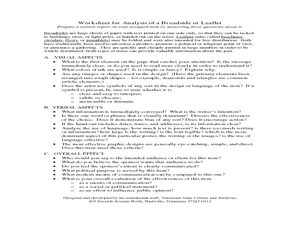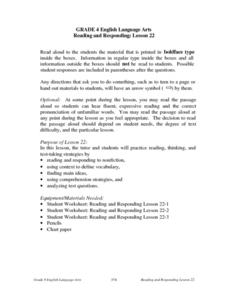Curated OER
Exploring Stars
Fifth graders explore the life cycle of stars. They analyze small, medium, and large stars and view a video that compares the life cycles of the various sized stars. They create a flipbook movie detailing the life cycles of a star and...
Curated OER
Lesson 3: Making Predictions
In this making predictions worksheet, students read a newspaper article, locate the "Five Ws and the H," and then make logical predictions on the content that they read and then analyze those predictions based on a rubric.
Curated OER
Technical Literacy
Students explore the components of the transference of technological information through this ten lesson unit. The applications to specific careers, the determination of responsible use of technology, and the affects of technology on...
Curated OER
Celebrating the Individuals in Our Community
Students research, write and publish a biography on a community member. They interview the community member, collect and scan photos, produce and edit text and use software to puslish an online book.
Curated OER
Biographical Account--John Lennon
Learners develop skills of biographical writing through research. Students analyze a video on John Lennon and his death. Learners visit the website on John Lennon still recording details of his death.
Curated OER
Colonial Research Fun
Students review the characteristics of the thirteen colonies. In groups, they use the internet to research one of the colonies more in depth and answer questions about it. They develop a newspaper or travel brochure to share the...
Curated OER
Art and Artists
Students effectively gather and use information for research purposes. They comprehend the visual arts in relation to history and culture. Students practice note taking skills, and summarizing skills. They know and compare the...
Curated OER
Focus on the Media
Students critically examine news articles and editorials for attitudes of discrimination and prejudice. Students then complete checklist in which they analyze news reports for context, content, point of view, language, graphics, and...
Curated OER
Worksheet for Analysis of a Broadside or Leaflet
In this primary source analysis worksheet, students respond to 15 short answer questions that require them to analyze leaflets or brochures of their choice.
Curated OER
Rights and the Wyandotte Constitution
Young scholars use graphic organizers to analyze the Wyandotte Constitution. They read and discuss the Wyandotte Constitution, identify the civil rights granted to the people of Kansas and consider exceptions based on gender and race.
Curated OER
Reading and Responding
Fourth graders read and respond to poetry. They identify the author's purpose and connect the literature to their personal experiences. Students critically analyze the poem and write a poem of their own.
Curated OER
Mystery Cemetary: Teachers
Learners examine and analyze the skeletons of various bodies that could represent a cemetary. In groups, they identify a set of common characteristics in which the skeletons are grouped. To end the lesson, they answer questions related...
Curated OER
Read a Pictograph
In this data display instructional activity, students solve 4 problems in which data on a tally chart and pictograph are analyzed. Students use this information to solve the problems.
Curated OER
Concept: Superstition
Students identify the role of superstition in their own lives, in society, and in Mark Twain's The Adventures of Tom Sawyer. In this superstition lesson, students discuss urban legends and listen to a related song to introduce the topic....
Curated OER
Natural Disasters: Nature's Fury
Young scholars explore the human experience. In this business ethics instructional activity, students analyze primary sources to develop an understanding of the American natural disasters of the 19th and 20th centuries and the...
Curated OER
Characters in Nathaniel Hawthorne's Stories
Students read literature by Nathaniel Hawthorne and write an essay comparing the main characters in the two stories. In this character analysis activity, students read the stories Young Goodman Brown and The Minister's Black Veil....
Curated OER
Dogs vs. Cats: Pet Ownership Essay
Students analyze patterns of organization used in writing to determine how and when comparisons and contrasts can be effectively utilized to identify similarities and differences or pros and cons.
Curated OER
Analysis of Theme in Impressionist writing
Eleventh graders explore the concepts of Impressionism and theme. They choose a section of narration which presents Henry Fleming's vision of war. They analyze this section to determine which images invoke the senses: sight, sound,...
Curated OER
Colored Dots 1
Students observe that colored markers are a mixture of many different colors by performing a chromatography experiment. They make observations, record information, and make generalized inferences from their observations.
Curated OER
Some of Its Parts
Students study a can opener to find the important parts that make it possible to take the lid off a can of food. They then use this information to decide what new or different subsystems could be added to make it better and explain how...
Curated OER
Dinosaurs
Students research and identify the characteristics of a variety of dinosaurs. They participate in a class discussion about dinosaurs, analyze and examine fossils, and conduct research using a variety of sources to write and present a...
Curated OER
ADULT ESOL LESSON PLAN--Safety and Security
Students, after reviewing and drilling on a unique vocabulary list of terms, analyze the proper procedures for fire, crime or medical emergencies. They examine how to stay calm and collected during such emergencies and why its important...
Curated OER
Hot Gas Or Cold Gas Lab
Students engage in a lab project to study chemical reactions. They use guided questions to help facilitate the lab experience and come to the correct outcomes. The lesson does not contain a true understandable objective. The lesson could...
Curated OER
Human Development: The First Trimester & Developmental Malformations
Students, analyze and discuss cleft lip, cleft palate, anencephaly, spina bifida and septal defects in the heart--well-known malformations that can occur in the first trimester of prenatal devalopment. They play the review game, Fetal...

























